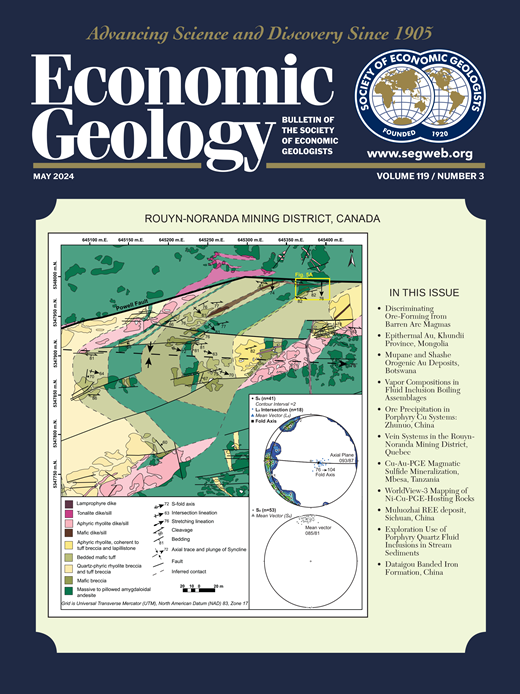Insights from 3-D Structural and Lithological Geomodeling of K.O.V. Mine, Kolwezi Region, Democratic Republic of the Congo: Olistostromes in an Evolving Lufilian Arc Foreland Basin
IF 4.9
1区 地球科学
Q1 GEOCHEMISTRY & GEOPHYSICS
引用次数: 0
Abstract
The Kolwezi area of the Democratic Republic of the Congo hosts world-class stratabound Cu-(Co) and U-(± Cu-Ni-Co-Pb-Zn) mineralization within large fragments (écaille) of Lower Roan Group units that are hosted in the regional Roan breccia. Long-debated genetic models for the development of these types of deposits include the development of tectonic mélanges, friction breccias, sedimentary mélanges, olistostromes, and halokinesis or salt tectonics. Compiled historical data and new data at K.O.V. mine, which is an amalgamation of the Kamoto-East, Oliveira, and Virgule mines, situated in the Kolwezi “klippe” or subbasin, has been reanalyzed and used in the construction of a new, fully constrained, implicit 3-D model of lithologies and major structures. This data, which spans approximately 80 years, includes diamond and reverse-circulation drilling, new structural and lithological mapping data, downhole televiewer data, and macrostructural logging. In-pit observations, combined with these new, fully constrained, implicit 3-D models, provide new insights into the geometry and genesis of these deposits and their encompassing volume. The Kolwezi subbasin, characterized by K.O.V. mine, resulted from gravity-driven mass transport processes, concomitant with sedimentary deposition within a progressively folded foreland basin during orogenesis. The final geometry of fragments is due to (1) features that were inherited from the fold-and-thrust belt in the hinterland; (2) features caused by incorporation and dismemberment of fragments throughout a regional Roan breccia, as they were shed into the foreland basin; and (3) large-scale juxtaposition and impingement of fragments, complicated by late-kinematic tightening of the Kolwezi subbasin, further dewatering of the pile, and possibly further remobilization of fluids and metals. Collectively, these features, typified by K.O.V. mine, indicate that the Kolwezi subbasin, the Tombolo subbasin, and book similar regions in the foreland constitute the localized, preserved remnants of an olistostrome that was deposited within a previously much larger foreland basin, ahead of an advancing, thin-skinned fold-and-thrust system, and against the Nzilo block on the western margin of the Lufilian arc.来自刚果民主共和国Kolwezi地区K.O.V.矿三维构造和岩性地质建模的启示:演化中的陆菲连弧前陆盆地的橄榄岩
刚果民主共和国的Kolwezi地区拥有世界级的层控铜(Co)和U-(±Cu- ni -Co- pb - zn)矿化,这些矿化位于Roan角砾岩的下Roan群单元的大块(samcaille)内。对于这类矿床的发育,长期争论的成因模式包括构造岩、摩擦角砾岩、沉积岩、浮岩和盐构造的发育。K.O.V.矿是位于Kolwezi“klippe”或次盆地的Kamoto-East、Oliveira和Virgule矿的合并,已对K.O.V.矿的汇编历史数据和新数据进行了重新分析,并用于构建新的、完全受限的、隐式的岩性和主要构造三维模型。这些数据跨度约为80年,包括金刚石和反循环钻井、新的构造和岩性测绘数据、井下电视观测数据以及宏观构造测井。与这些新的、完全受限的隐式三维模型相结合的井下观测,为这些矿床的几何形状、成因及其包裹体积提供了新的见解。以K.O.V.矿为特征的Kolwezi次盆地,是在造山过程中,由重力驱动的物质搬运过程和逐渐褶皱的前陆盆地内的沉积作用共同形成的。碎屑体的最终几何形状是由于(1)从腹地的褶皱冲断带继承下来的特征;(2)区域罗安角砾岩碎屑在进入前陆盆地过程中被整合和肢解形成的特征;(3)碎片的大规模并置和撞击,加之Kolwezi次盆地后期的运动收紧、桩的进一步脱水以及可能的流体和金属的进一步再活化。总的来说,以K.O.V.矿为代表的这些特征表明,Kolwezi次盆地、Tombolo次盆地以及前陆地区的其他类似地区构成了一个局部保存下来的橄榄断层的残余物,该橄榄断层沉积在以前更大的前陆盆地内,在一个向前推进的薄皮褶皱-冲断体系之前,并在陆菲连弧西缘的Nzilo地块上。
本文章由计算机程序翻译,如有差异,请以英文原文为准。
求助全文
约1分钟内获得全文
求助全文
来源期刊

Economic Geology
地学-地球化学与地球物理
CiteScore
10.00
自引率
6.90%
发文量
120
审稿时长
6 months
期刊介绍:
The journal, now published semi-quarterly, was first published in 1905 by the Economic Geology Publishing Company (PUBCO), a not-for-profit company established for the purpose of publishing a periodical devoted to economic geology. On the founding of SEG in 1920, a cooperative arrangement between PUBCO and SEG made the journal the official organ of the Society, and PUBCO agreed to carry the Society''s name on the front cover under the heading "Bulletin of the Society of Economic Geologists". PUBCO and SEG continued to operate as cooperating but separate entities until 2001, when the Board of Directors of PUBCO and the Council of SEG, by unanimous consent, approved a formal agreement of merger. The former activities of the PUBCO Board of Directors are now carried out by a Publications Board, a new self-governing unit within SEG.
 求助内容:
求助内容: 应助结果提醒方式:
应助结果提醒方式:


